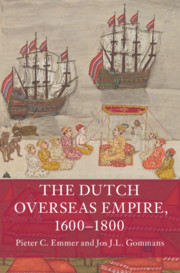Book contents
- The Dutch Overseas Empire, 1600–1800
- Additional material
- The Dutch Overseas Empire, 1600–1800
- Copyright page
- Contents
- Figures
- Cover Image
- Maps
- Note on Terminology
- Preface
- Frontispiece
- Introduction
- Part I The Grumbling Hive
- Part II The Atlantic World
- Part III Monsoon Asia
- Introduction
- 7 The Dutch Tropics
- 8 The Indian Ocean
- 9 The South China Sea
- Conclusion
- Coda
- References
- Index
8 - The Indian Ocean
from Part III - Monsoon Asia
Published online by Cambridge University Press: 29 September 2020
- The Dutch Overseas Empire, 1600–1800
- Additional material
- The Dutch Overseas Empire, 1600–1800
- Copyright page
- Contents
- Figures
- Cover Image
- Maps
- Note on Terminology
- Preface
- Frontispiece
- Introduction
- Part I The Grumbling Hive
- Part II The Atlantic World
- Part III Monsoon Asia
- Introduction
- 7 The Dutch Tropics
- 8 The Indian Ocean
- 9 The South China Sea
- Conclusion
- Coda
- References
- Index
Summary
After an in-depth analysis of the making of Dutch territorial power in the Indonesian archipelago, Ceylon and Malabar, the two final chapters take an even more Asian perspective on the more marginal Dutch presence in South and West Asia. Through a Dutch window, this chapter perceives a so far undetected Indian world-economy that focuses on the bustling Mughal port city of Surat. Other regional chapters likewise stress the crucial role of Indian commercial brokers, not only in the Indian subcontinent but extending towards the Red Sea and the Persian Gulf. The Dutch can only accede to these already highly sophisticated and integrated trading systems of the Indian Ocean. Their operations are crucially facilitated by their increasingly monopolised access to both Indonesian spices and Japanese bullion. Despite its marginal position in the Mughal and Safavid Empires, it was not the spices of the archipelago and Ceylon, but the products of India (opium, saltpetre and in particular textiles) which started to dominate the global markets of the eighteenth century. These commodities gave the edge to the previously overpowered but now re-emerging British, be it as Company or, increasingly so, as private traders.
Keywords
- Type
- Chapter
- Information
- The Dutch Overseas Empire, 1600–1800 , pp. 311 - 352Publisher: Cambridge University PressPrint publication year: 2020



